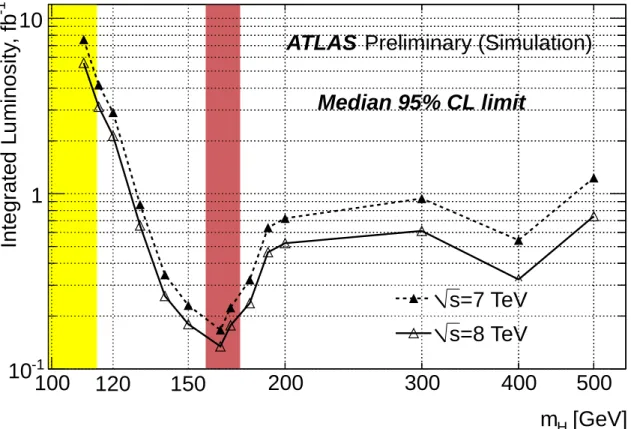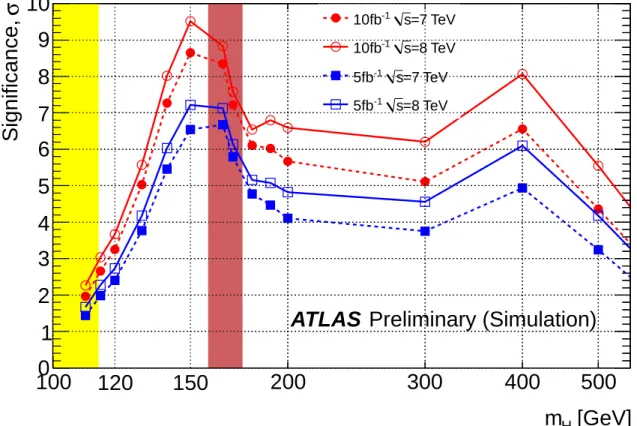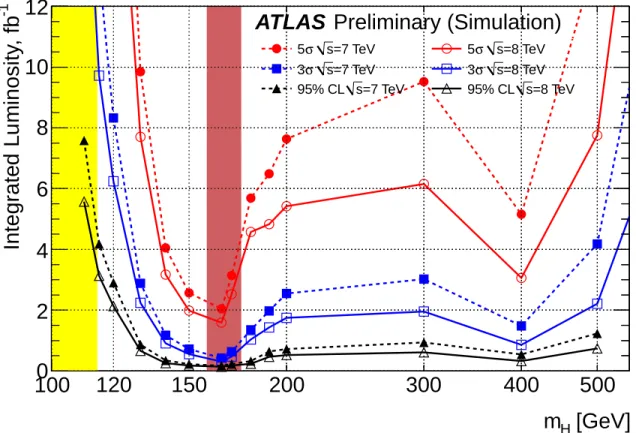ATL-PHYS-PUB-2011-001 22January2011
ATLAS NOTE
January 22, 2011
Further investigations of ATLAS Sensitivity to Higgs Boson Production in different assumed LHC scenarios.
The ATLAS Collaboration
Abstract
Projections for the ATLAS sensitivity to the Standard Model Higgs boson from LHC running at centre-of-mass energies of √
s = 7 and 8 TeV are reported. These studies ex- tend our previous results by considering the luminosities required to reach 5σ discovery significance. The projections are largely derived using cross-sections rescaling to different centre-of-mass energies.
The ATLAS experiment, with 1 fb−1 of data taken at √
s = 7 TeV and using rather conservative assumptions, should have sensitivity such that Higgs boson masses between 130 GeV and 460 GeV have at least a 50% chance of being excluded at 95% CL. If 5 fb−1at
√s=8 TeV is available, 3σevidence can be expected for a Higgs boson with mass between 125 and 500 GeV or down to the LEP limit if optimized analyses are used. If 10 fb−1of data taken at √
s=8 TeV is analysed with an optimised analysis, the 5σdiscovery region covers a mass range from 120 GeV to over 500 GeV.
1 Introduction
The ATLAS experiment has released a note [1] describing sensitivity to the Standard Model Higgs boson at √s = 7-9 TeV and for luminosities of 0.5 to 5 fb−1. This document extends that by considering integrated luminosities of order 10 fb−1in order to establish 5σdiscovery significances.
The results contained here are mostly based upon a conservative analysis scenario, using cut based techniques and robust systematic error estimates. A more optimised analysis is also considered. The decay modes considered in this note are H→γγ, H →ZZ(∗) →l+l−l+l−, H→WW [2], H→τ+τ−[3], H →b¯b [4], H →ZZ → l+l−ν¯νand H →ZZ →l+l−b¯b [1]. All analysis assumptions are precisely as documented in the previous study. For example, all analyses use cross-sections and branching ratios, as discussed in Ref. [1], even though there are small updates in Ref. [5].
The most important single analysis at most masses is the H→WW channel. It is therefore especially significant that the first data measurements [6] find backgrounds similar to those used in the simulations upon which these current projections are based.
The energy dependence of the results here is obtained using cross-section rescaling. The H →γγ, H → ZZ(∗) → l+l−l+l−, H → WW analyses were originally simulated at 10 TeV, H → τ+τ− and H→b¯bat 14 TeVand the H →ZZ →l+l−ν¯νand H →ZZ →l+l−b¯b channels at 7 TeV. The signal and background yields are scaled between different energies with kinematic selection made at the generator level to calculate sensitivities at √
s = 7 and 8 TeV. A range of integrated luminosities is investigated, from 500 pb−1to 30 fb−1, to understand how the expectations depend upon this quantity. All the sensi- tivity studies are performed using the profile-likelihood method [3], where nuisance parameters, such as background rates, are treated by finding the best-fit value. Limits, all at 95% CL, are extracted using a fixedδlogLthreshold, but in cases of low expected event numbers either the threshold is raised to give approximate coverage or toy Monte Carlo experiments are used to obtain the limit.
The effects of both pile-up and cavern background have been studied for some of the channels de- scribed herein and are documented in the previous notes [2, 3, 7]. The new analyses, namely H→ZZ → l+l−ν¯νand H → ZZ → l+l−b¯b have undertaken preliminary studies of lepton identification, jet rates and missing energy under the influence of two pile-up interactions per event, as occurred at the LHC in August 2010, and no significant degradation in performance is observed.
Systematic uncertainties described in Refs. [2–4, 7] are taken into account in the estimation of the exclusion limits presented in this note. The performance of the ATLAS detector often exceeds the expec- tations used in these studies. For example, the jet energy scale found in Ref. [8] is known to better than the 10% assumed here and further improvements should be expected. A common correlated luminosity error of 11% is applied to all channels, which is also rather conservative.
The combined results are detailed in Section 2 and some conclusions are drawn in Section 3.
2 Combination
The results of the individual analyses are combined using the profile likelihood method [3], as was used in a previous note on Higgs boson sensitivity [2]. That study compared the expected limits found using the profile likelihood and the CLsmethod [9] in the H →γγchannel, and the former gave limits approximately 15% smaller in signal rate.
All analysis channels are included where they provide results. These are then fitted to the optimal values of the nuisance parameters, and the profile likelihood value is used to extract the limits. In order to improve coverage the limits are not quoted at aδlogLof 1.35, (where, on equatingχ2to 2δlogL, the corresponding P(χ2) is 10%, or 5% in the upper tail), but the limit is set at 1.7 as an approximation which retains approximate 5% coverage in the mass range 120-200 GeV. For the H →γγ, H→ZZ →l+l−ν¯ν and H → ZZ → l+l−b¯b channels fits are done to distributions while the other channels are treated as
number counting experiments.
Analyses were run to extract the multiple of the Standard Model (SM) cross-section for which a particular sensitivity is expected. These are plotted in our previous note [1]. For this note we choose to present first the luminosity required for a 95% CL SM Higgs boson exclusion instead. This is estimated by fitting the cross-section multiplier extracted at 0.5, 1, 2 and 5 fb−1 to a function of the form σ ∝ 1/Lα. The exponentαwould be 0.5 in a background dominated regime with no systematics. In fact it varies from 0.6 to 0.35, with the minimum at 170 GeV where the systematic errors are important. This expression is used to find the integrated luminosity at which sensitivity to the SM rate is achieved. If that luminosity is outside the range 0.5 to 5 fb−1in which the function was fitted, then the luminosity is re-calculated using a simple 1/√
Lscaling through the 1 fb−1point and the more conservative result is quoted. This procedure affects mostly the region around 165 GeV where the luminosities are of order 0.1 fb−1, considerably outside the tested range.
Unlike the exclusion limit, The 5σdiscovery significances are extracted at a range of different lumi- nosities between 2 and 30 fb−1. The sensitivity is found using Wilks’ theorem [10], which gives rise to somewhat conservative numbers when compared to the p-value treatment used in our previous note [1], but eases computation at 5 sigma. These are then interpolated, again using aσ ∝ 1/Lαto find the lu- minosities corresponding to 3σand 5σ. For the 5σdiscovery significance an interpolation is possible at most points. There are only 3 points requiring extrapolations for discovery significance: 110, 115 and 600 GeV, all of which are a little over 30 fb−1.
The scan used above to extract 5σsignificance has also been used to estimate the 3σevidence point.
In most cases this involves extrapolating down from about 4σ, but it has been checked that removing the lowest luminosity scan point changes the fitted results by less than, or of order, 5%.
The combination of all channels at √
s = 7 or 8 TeV is shown in Fig. 1 in terms of the luminosity required to set a 95% CL exclusion limit. A dataset of 1 fb−1at √
s=7 TeV allows a median expectation of exclusion of the SM Higgs boson between 130 GeV and 460 GeV. There is however considerable expected spread in the observations and in the presence of fluctuations of around 2σexclusion might, or might not, occur at any mass in the range considered. To achieve a 50% chance or better of SM exclusion for masses above the LEP limit [11] and below 500 GeV, 4 fb−1at √
s=7 TeV are required, or 3 fb−1at
√s=8 TeV.
Figures 2 and 3 show respectively the expected significance versus mass for fixed luminosity and the luminosity required to make an observation or discovery. The luminosity required for particular significances are also given numerically in Table 1.
Table 1: The luminosity required, as a function of mH, to give 50% probability of obtaining a 95% CL exclusion, 3σevidence or 5σdiscovery for either √
s=7 or 8 TeV centre-of-mass energy.
Type E.C.M. mH(GeV)
115 120 130 140 150 165 170 180 190 200 300 400 500
95% CL 7 TeV 4.2 2.9 0.9 0.3 0.2 0.2 0.2 0.3 0.6 0.7 0.9 0.5 1.2
8 TeV 3.1 2.1 0.7 0.3 0.2 0.1 0.2 0.2 0.5 0.5 0.6 0.3 0.7
3σ 7 TeV 13 8.3 2.9 1.2 0.7 0.4 0.6 1.3 2.0 2.5 3.0 1.5 4.2
8 TeV 9.7 6.2 2.2 0.9 0.6 0.3 0.5 1.0 1.4 1.8 2.0 0.9 2.2
5σ 7 TeV 44 27 9.8 4.0 2.6 2.0 3.1 5.7 6.5 7.6 9.5 5.2 14
8 TeV 33 21 7.7 3.2 2.0 1.6 2.5 4.6 4.8 5.4 6.2 3.1 7.8
An optimised analysis selection was also used in Ref. [1]. This applied to approximate gains which expected to be achievable in the analysis performance, but not in fact demonstrated. The largest sensitiv- ity improvement is estimated in the H→γγchannel, where improvements of 80% in the effective signal strength were found in Ref. [3] by using Higgs boson candidate pTand decay angles, the number of jets
[GeV]
mH
100 200 300 400 500
-1 Integrated Luminosity, fb
10-1
1 10
=7 TeV s
=8 TeV s
Median 95% CL limit
120 150
ATLAS Preliminary (Simulation)
Figure 1: The luminosity required, as a function of mH, to give a median exclusion significance of 95%
CL for a SM Higgs at √
s = 7 or 8 TeV. The shaded regions are the regions excluded by LEP [11], (yellow or light) and the Tevatron [12] (brown or dark).
[GeV]
mH
100 200 300 400 500
σSignificance,
0 1 2 3 4 5 6 7 8 9
10 10fb-1 s=7 TeV
=8 TeV s
-1 10fb
=7 TeV s
-1 5fb
=8 TeV s
-1 5fb
120 150
ATLAS Preliminary (Simulation)
Figure 2: The expected level of significance as a function of mHfor 5 or 10 fb−1of luminosity at √ s=7 or 8 TeV.
[GeV]
mH
100 200 300 400 500
-1 Integrated Luminosity, fb
0 2 4 6 8 10 12
=7 TeV s σ
5 5σ s=8 TeV
=7 TeV s σ
3 3σ s=8 TeV
=7 TeV s
95% CL 95% CL s=8 TeV
120 150
ATLAS Preliminary (Simulation)
Figure 3: The luminosity required to give exclusion, evidence or discovery sensitivity for a SM Higgs with data at √
s=7 or 8 TeV.
and various identification classes of photons. Here a more modest 50% gain is assumed, with smaller gains in the other channels. The results using this performance are shown in Fig 4.
[GeV]
mH
100 200 300 400 500
-1 Integrated Luminosity, fb
0 2 4 6 8 10 12
=8 TeV s
σ
5 5σ Opt s=8 TeV
=8 TeV s
σ
3 3σ Opt s=8 TeV
=8 TeV s
95% CL
120 150
ATLAS Preliminary (Simulation)
Figure 4: The luminosity required to give exclusion, evidence or discovery sensitivity for a SM Higgs with data at √
s=8 TeV using the normal or optimised analysis. The latter was only run below 140 GeV.
The luminosities required for a 3σobservation or 5σdiscovery are shown in Figs. 3 and 4. There is a region, extending from Higgs boson masses of 132 to 480 GeV, where 2 fb−1 at √
s = 8 TeV would be expected to lead to evidence at 3σ level. If the optimised analysis is used then 5fb−1will give 3σ sensitivity for all allowed masses up to over 500 GeV. If 10 fb−1 becomes available then there is a 5σ sensitivity region from 120 GeV to over 500 GeV, again assuming √
s=8 TeVand the optimised analysis.
This might be considered as the result of combining two comparable experiments.
3 Conclusions
The estimated ATLAS sensitivity to the Standard Model Higgs boson using between 0.5 and 10 fb−1of LHC data at √
s=7 and 8 TeV have been presented.
The mass range in which a Standard Model Higgs boson would be expected to be excluded if it is not there is 130 GeV to 460 GeV if 1 fb−1at √
s=7 TeV is available. A factor two increase in the integrated luminosity would decrease the lower sensitivity bound by some 7 GeV, while the same amount of data delivered at √
s=8 TeV instead would extend the range by only around 2.5 GeV. If 5 fb−1at √
s=8 TeV is available, optimised analyses would be expected to lead to evidence at the 3σlevel for any allowed Higgs mass below 500 GeV.
A discovery significance of 5σ can be expected for Higgs boson masses between 120 GeV and 500 GeV if optimised analyses are used with 10 fb−1at √
s=8 TeV.
References
[1] ATLAS Collaboration, ATLAS Sensitivity Prospects for 1 Higgs Boson Production at the LHC Running at 7, 8 or 9 TeV,
http://cdsweb.cern.ch/record/1303604/files/ATL-PHYS-PUB-2010-015.pdf.
ATL-PHYS-PUB-2010-015 .
[2] ATLAS Collaboration, ATLAS Sensitivity Prospects for Higgs Boson Production at the LHC Running at 7 TeV, http://cdsweb.cern.ch/record/1278455/files/ATL-PHYS-PUB-2010-009.pdf, 2010. ATL-PHYS-PUB-2010-009 (2010) .
[3] ATLAS Collaboration, Expected Performance of the ATLAS Experiment - Detector, Trigger and Physics, arXiv:0901.0512 [hep-ex] .
[4] ATLAS Collaboration, ATLAS Sensitivity to the Standard Model Higgs in the HW and HZ Channels at High Transverse Momenta,
http://cdsweb.cern.ch/record/1201444/files/ATL-PHYS-PUB-2009-088.pdf, 2009.
ATL-PHYS-PUB-2009-088 (2009) .
[5] LHC Higgs Cross Section Working Group, S. Dittmaier, C. Mariotti, G. Passarino,
R. Tanaka (Eds.), et al., Handbook of LHC Higgs Cross Sections: 1. Inclusive Observables, arXiv:1101.0593 [hep-ph].
[6] ATLAS Collaboration, Observation of the Background from W+jets to the H →WW→ℓνℓν Search with the ATLAS detector at 7 TeV,
https://atlas.web.cern.ch/Atlas/GROUPS/PHYSICS/CONFNOTES/ATLAS-CONF-2010-092/, 2010. ATLAS-CONF-2010-092 (2010) .
[7] Prospects for Higgs Boson Searches using the H→WW(∗)→ℓνℓνDecay Mode with the ATLAS Detector for 10 TeV, http://cdsweb.cern.ch/record/1270568/files/ATL-PHYS-PUB-2010-005.pdf, Jun, 2010.
[8] ATLAS Collaboration, Measurement of jet production in proton-proton collisions at 7 TeV centre-of-mass energy with the ATLAS Detector,
https://atlas.web.cern.ch/Atlas/GROUPS/PHYSICS/CONFNOTES/ATLAS-CONF-2010-050/, 2010. ATLAS-CONF-2010-050 (2010) .
[9] The TEVNPH Working Group of the CDF and D0 Collaboration, Combined CDF and D0 Upper Limits on Standard Model Higgs- Boson Production with up to 6.7 fb−1of Data,
arXiv:1007.4587 [hep-ex].
[10] S. Wilks, The large-sample distribution of the likelihood ratio for testing composite hypotheses , Ann. Math. Statist. 9 (1938) 60–62.
[11] LEP Working Group for Higgs boson searches Collaboration, R. Barate et al., Search for the standard model Higgs boson at LEP, Phys. Lett. B565 (2003) 61–75,arXiv:hep-ex/0306033.
[12] CDF and D0 Collaboration, T. Aaltonen et al., Combination of Tevatron searches for the standard model Higgs boson in the W+W- decay mode, Phys. Rev. Lett. 104 (2010) 061802,
arXiv:1001.4162 [hep-ex].




